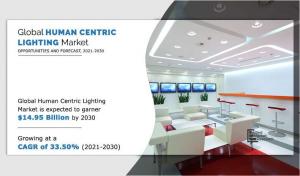
Human Centric Lighting Market Expected to Reach $14.95 Billion by 2030
— Allied Market Research
WILMINGTON, DELAWARE, DELAWARE, June 10, 2024 /EINPresswire.com/ — The human centric lighting market is expected to witness a high growth rate during the forecast period, owing to an increase in the need for energy-efficient lighting and high adoption of LED lighting solutions. Various product launches and advancements in technologies in the lighting market are anticipated to offer huge growth potential for the human centric lighting market. Allied Market Research, titled, “Human Centric Lighting Market by Offering, Installation Type, and Application: Global Opportunity Analysis and Industry Forecast, 2021–2030.
𝐃𝐨𝐰𝐧𝐥𝐨𝐚𝐝 𝐑𝐞𝐬𝐞𝐚𝐫𝐜𝐡 𝐑𝐞𝐩𝐨𝐫𝐭 𝐒𝐚𝐦𝐩𝐥𝐞 & 𝐓𝐎𝐂: https://www.alliedmarketresearch.com/request-sample/A12973
The global human centric lighting market size was valued at $0.91 billion in 2020 and is projected to reach $14.95 billion by 2030, registering a CAGR of 33.50%. North America is expected to be the leading contributor to the global market during the forecast period, followed by Europe and Asia-Pacific.
Human centric lighting is a lighting solution that puts the focus on bringing the dynamics of natural daylight back into people’s everyday lives through biologically effective artificial lighting. Human centric lighting goes beyond the basic visual needs of people and helps the human body to stay aligned with natural circadian rhythms. In addition, human centric lighting supports human health, well-being, and performance through deterministic and holistic planning and implementation of visual, emotional, and in particular, biological effects of light.
The emergence of advanced lighting technologies, including LEDs, smart bulbs, and intelligent fixtures is promoting the implementation of smart & controllable light systems, enhancing the market share. LEDs offer huge energy savings, flexibility, and reliability, and are now entering nearly every application in the environment. Reduction in energy consumption and its subsequent cost are the key factors making LED a preferred choice over conventional lights.
In addition, several leading manufacturers are focusing on strategic partnerships and product portfolio expansion to enhance their market share. For instance, in December 2020, signify entered into a partnership with Honeywell to deploy smart and integrated lighting solutions for commercial buildings. This partnership will help the companies to extend their services to a mass audience.
The prominent factors that impact the human centric lighting market growth are an increase in the need for energy-efficient lighting, the high development of smart lighting systems, and the high usage of LED lighting solutions.
𝐆𝐞𝐭 𝐂𝐮𝐬𝐭𝐨𝐦𝐢𝐳𝐞𝐝 𝐑𝐞𝐩𝐨𝐫𝐭𝐬 𝐰𝐢𝐭𝐡 𝐲𝐨𝐮’𝐫𝐞 𝐑𝐞𝐪𝐮𝐢𝐫𝐞𝐦𝐞𝐧𝐭𝐬: https://www.alliedmarketresearch.com/request-for-customization/A12973
𝐂𝐨𝐦𝐩𝐞𝐭𝐢𝐭𝐢𝐯𝐞 𝐀𝐧𝐚𝐥𝐲𝐬𝐢𝐬:
The Human Centric Lighting industry’s key market players adopt various strategies such as product launches, product development, collaboration, partnership, and agreements to influence the market. It includes details about the key players in the market’s strengths, product portfolio, market size and share analysis, operational results, and market positioning.
𝐒𝐨𝐦𝐞 𝐨𝐟 𝐭𝐡𝐞 𝐦𝐚𝐣𝐨𝐫 𝐤𝐞𝐲 𝐩𝐥𝐚𝐲𝐞𝐫𝐬 𝐢𝐧 𝐭𝐡𝐞 𝐠𝐥𝐨𝐛𝐚𝐥 𝐇𝐮𝐦𝐚𝐧 𝐂𝐞𝐧𝐭𝐫𝐢𝐜 𝐋𝐢𝐠𝐡𝐭𝐢𝐧𝐠 𝐌𝐚𝐫𝐤𝐞𝐭 𝐢𝐧𝐜𝐥𝐮𝐝𝐞,
Signify Lighting NV
OSRAM AG
Acuity Brands, Inc.
Cree, Inc.
Legrand SA
Hubbell Inc.
Lutron Electronics Co., Inc.
Zumtobel Group AG
Philips NV
Wipro Enterprises Ltd.
However, high installation and maintenance cost restricts the market growth. On the contrary, the rising adoption of wireless technology for lighting systems is expected to create lucrative opportunities for the market. Therefore, these factors are expected to affect the global human centric lighting industry during the forecast period.
Region-wise, the human-centric lighting market trends are analyzed across North America (the U.S., Canada, and Mexico), Europe (Germany, the UK, France, Italy, and the rest of Europe), Asia-Pacific (China, Japan, India, South Korea, and the rest of Asia-Pacific), and LAMEA (Latin America, the Middle East, and Africa). Asia-Pacific is expected to grow at the highest CAGR during the forecast period, owing to rapid urbanization and infrastructure activities. Leading countries such as China, India, and Japan are witnessing significant demand for human centric lighting systems from commercial, residential, and healthcare applications, thereby driving the market growth in Asia-Pacific. The overall human centric lighting market analysis is determined to understand the profitable trends to gain a stronger foothold.
𝐂𝐎𝐕𝐈𝐃-𝟏𝟗 𝐈𝐦𝐩𝐚𝐜𝐭 𝐀𝐧𝐚𝐥𝐲𝐬𝐢𝐬
The COVID-19 pandemic has significantly impacted global economies, resulting in workforce & travel restrictions, supply chain & production disruptions, and reduced demand & spending across many sectors. A sudden decline in infrastructure development and installation projects is expected to hamper the market growth for residential, commercial, and industrial verticals.
The human centric lighting market revenue witnessed a dip in its growth rate, owing to delayed construction projects, which led to a substantial impact. However, the demand from the medical industry has accelerated during the pandemic. Furthermore, market players have been investing in the R&D of lighting systems, owing to increasing governmental initiatives across the world. Therefore, the human centric lighting market size is anticipated to gain momentum by the end of 2021.
𝐈𝐧𝐪𝐮𝐢𝐫𝐲 𝐛𝐞𝐟𝐨𝐫𝐞 𝐁𝐮𝐲𝐢𝐧𝐠: https://www.alliedmarketresearch.com/purchase-enquiry/A12973
𝐊𝐞𝐲 𝐅𝐢𝐧𝐝𝐢𝐧𝐠𝐬 𝐨𝐟 𝐓𝐡𝐞 𝐒𝐭𝐮𝐝𝐲
– In 2020, the hardware segment accounted for maximum revenue and is projected to grow at a notable CAGR of 31.50% during the forecast period.
– The retrofit installation segment accounted for more than 45% of the global human centric lighting market share in 2020.
– The residential segment witnesses the highest growth rate during the human centric lighting market forecast period.
– Germany was the major shareholder in the Europe human centric lighting market revenue, accounting for approximately 35% share in 2020.
𝐀𝐛𝐨𝐮𝐭 𝐔𝐬:
Allied Market Research is a top provider of market intelligence that offers reports from leading technology publishers. Our in-depth market assessments in our research reports consider significant technological advancements in the sector. In addition to other areas of expertise, AMR focuses on analyzing high-tech and advanced production systems. We have a team of experts who compile thorough research reports and actively advise leading businesses to enhance their current procedures. Our experts have a wealth of knowledge on the topics they cover. Also, they use a variety of tools and techniques when gathering and analyzing data, including patented data sources.
David Correa
Allied Market Research
+ 18007925285
email us here
Visit us on social media:
Facebook
Twitter
![]()
Originally published at https://www.einpresswire.com/article/718710246/human-centric-lighting-market-poised-to-garner-maximum-revenues-during-2021-2030



